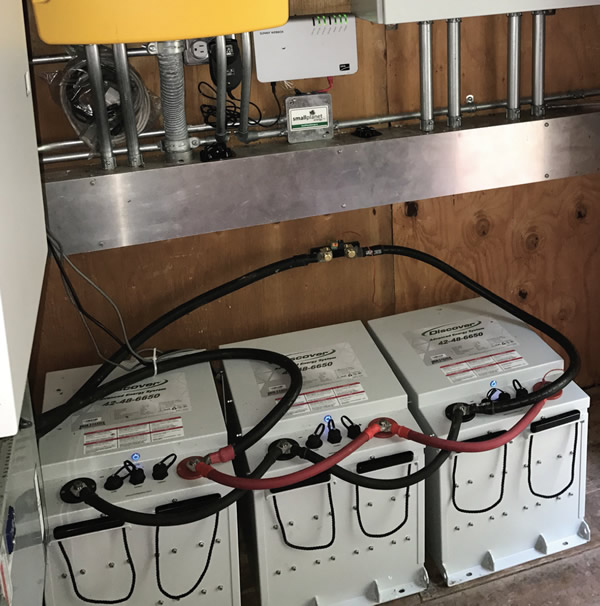This article is part of an occasional series that provides industry background and in-depth focus on the components that are available in HOMERⓇ Pro. What are the specifications of these products and what is the market context? We spoke with Discovery Battery’s representative, David Norman, to learn more:

Off-grid home with solar-plus-storage, powered by Discover AES batteries
Batteries are complicated mechanisms, orchestrating a subtle cascade of chemical and physical reactions to work their magic, and manufacturers are still experimenting to find the best combinations of materials. Battery technology is evolving rapidly, and in the renewable energy industry, lead-acid batteries have long been the standard. But, that battery choice is now giving way to the higher performance option of lithium batteries.
According to Norman, there is a wide range of chemistries that produce different performance characteristics across the spectrum of lithium-ion batteries. For example, power tools and electric vehicle batteries made by companies such as Tesla and Mercedes are typically nickel-based lithium ion. NMC chemistry is versatile, in that it can be tailored for high specific energy or high specific power, however, high charge currents can promote thermal runaway in nickel-based lithium batteries. Meanwhile, our computers and phones tend to be charged by lithium cobalt batteries because it has the highest energy density. Cobalt has a relatively short life span, limited load capabilities (specific power) and low thermal stability which make it susceptible to thermal runaway.
Lithium Iron Phosphate Batteries Boast Stability and Fast Charging
One type of lithium ion battery fast gaining popularity in the energy storage sector is the lithium iron phosphate battery and Norman explains why: “Lithium phosphate batteries are very stable and very safe,” he says. “They are the most stable of the lithium chemistry batteries and because of that, they are the most accepting of the high current required for fast charging.” The charging speed is the Holy Grail of energy storage batteries, because that’s the single biggest driver of operating costs.
 Why Spend the Money on Lithium Ion Batteries Now?
Why Spend the Money on Lithium Ion Batteries Now?
Lithium ion batteries are initially more expensive than lead acid batteries – which represent the majority of Discover’s business – and lithium ion cell costs are dropping rapidly, declining 73% since 2010. So why would a developer of solar-plus-storage systems not make do with the tried and trusted lead acid batteries for now, and wait till the price goes down before switching to lithium ion?
Norman explains that while there’s a cost reduction at a cell level, which is declining quickly in the case of lithium ion batteries, that doesn’t include product development costs or the surrounding components such as the casing and the controls. That’s a significant portion of battery cost these days, and it’s not declining as rapidly as the cell cost. But, says Norman, if you take battery performance into account, and consider any of either 10 year capital costs, cost per cycle used or cost per kilowatt hour stored, you’ll find that lithium ion batteries are ultimately less expensive than lead is today.
One important difference is maintenance and performance over time. Lead acid batteries are notoriously finicky, and require careful maintenance to retain their performance characteristics. Even with a perfect maintenance schedule, lead acid batteries degrade far more quickly than their new lithium ion cousins. When you discharge lead acid batteries, the electrolyte between the lead plates drops, exposing the plates to corrosion. That’s why manufacturers, including Discover, recommend that they not be discharged below 50% of their capacity. Lithium ion batteries, on the other hand, can be discharged 100% and they recharge five times faster than lead acid batteries. That means that a smaller bank of lithium ion batteries can do the same amount of work as a lead acid battery bank, so the cost comparison should not be thought of on a 1:1 basis.
Another important difference is lifespan. Lead acid batteries lose their capacity to recharge each time they cycle. Norman says lead acid batteries are considered “dead” if they are producing less than 60% of their initial capacity but start to impact system performance once they fall below 80%. A high quality lead acid battery is only expected to maintain its original, published capacity for 500 cycles (about 18 months of daily cycling). In contrast, Discover’s LiFeP04 battery has a 10 year, unlimited cycle, 38MW throughput warranty.
Battery Management Systems
One of the most exciting features of advanced battery technology is the Battery Management System (BMS). In the case of Discover, these are controls within individual batteries which manage charge and discharge rates and cell balancing in the battery pack that may be affected by different environmental factors (temperature and cell voltage, for example). The BMS has embedded communications which allow for coordination of multiple batteries in parallel and exchange of status and control data with other system components . In short, these BMS systems keep everything running smoothly, extending the lifetime of the batteries and reducing the costs of operation.
Within their Battery Management System, Discover has a feature called LYNK©, which provides networked communication with power electronics (such as the Schneider Electric XW+). LYNK optimizes charging setpoints to further reduce recharge times, enables SOC reporting and allows for external monitoring of the entire system over cloud services. Together these digital management systems enhance the performance of the energy storage system as a whole, and we’ll be exploring that in our next installment.
